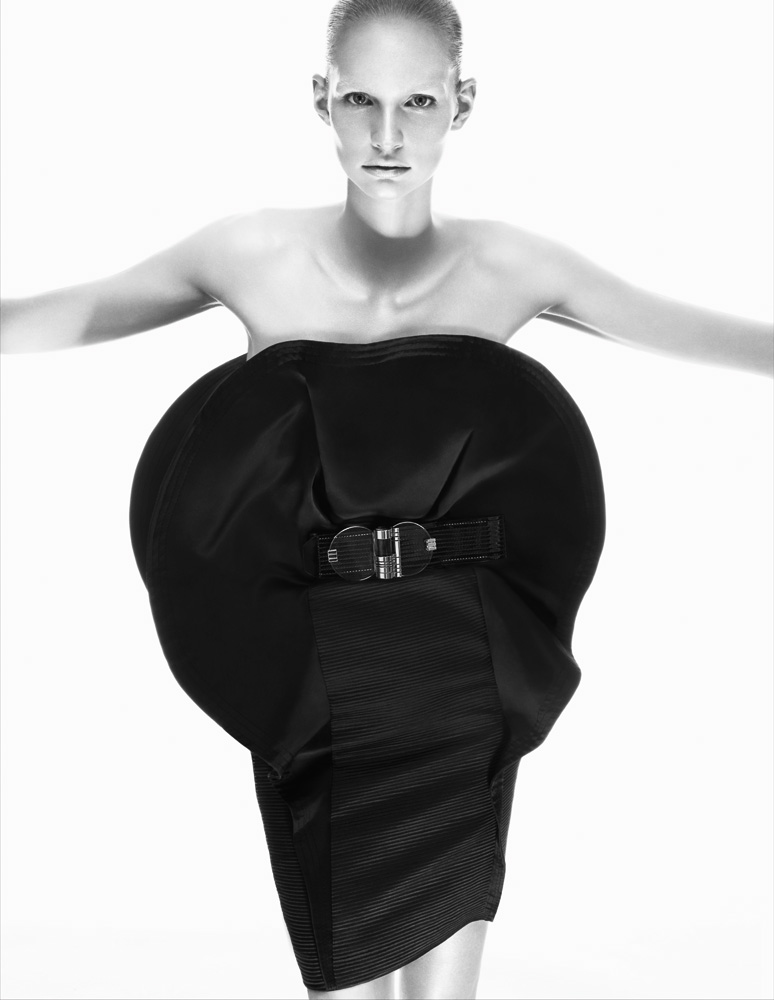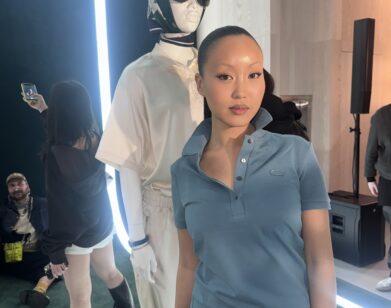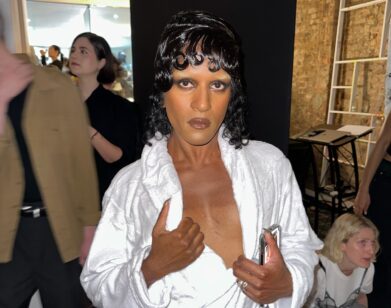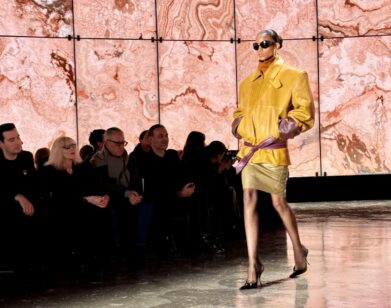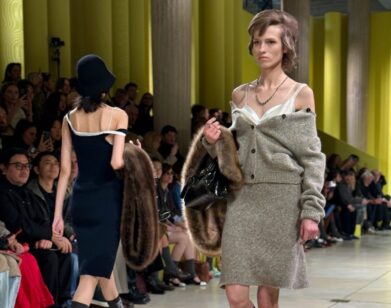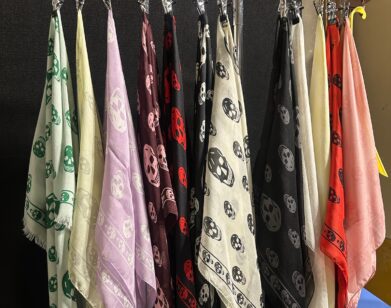Gianfranco Ferre
Milan, Italy: the Los Angeles ofEurope. A smog-filled, culturally parched economic engine in the middle of a famously lovely land, it is one of the world capitals of fashion. Since the crowning of Miuccia Pradaas a fashion queen in the early 1990s, there have been precious few new Italian designers for the world press to get jubilant over. It didnâ??t seem terribly likely that two designers who first met almost two decades ago while working at the venerable fashion house MaxMara would be the ones to shake things up. But with the 2005 debut of their line, 6267, Tommaso Aquilano and Roberto Rimondi married an inventive, futuristic sense of cut, shape, and proportion to the imaginative Italian eleganza thought to have expired back in the 1970s. The results made them must-sees on the Milan fashion calendar, and last year got them the prestigious job as top designers at the alta moda house of Gianfranco Ferré, whose famed namesake died in 2007.
The duoâ??s debut Ferré collection for Spring/Summer 2009 introduced the world to a stark, simple, yet fantastic vision of what seemed like well-bred but mischievous ladies from Marsâ??make that Mars circa 1966, envisioned by Federico Fellini. And despite financial troubles at Ferréâ??s parent company, IT Holding, the Ferré line is (at press time) holding steady. In New York last November, Aquilano (talkative and funny) and Rimondi (reticent and dry) held forth on why American women dress better than Italians, why youth is something weâ??re so desperate to lose and then twice as desperate to get back, and why, in the end, it comes back to Pierre Cardin and Elsa Schiaparelli. Doesnâ??t it always?
DAVID COLMAN: So, everyone ready? [pointing to Aquilanoâ??s finger] Thatâ??s a nice ring. What kind of stone is that? Or is it silver?
TOMMASO AQUILANO: It is, how do you call it, quarzo rutilato.
COLMAN: Rutilated quartz. People tend to think it has some sort of energyâ??you know, New Age.
AQUILANO: Really?
COLMAN: Well, they did in California in the â??90s. It never really caught on in New York. I had a stepmother who had this huge diamond on her finger all the time, and she always said that she believed in the power of crystals.
AQUILANO: Thatâ??s very funny. The diamond has a different power, I think.
COLMAN: How would you rate the energy of New York compared to Milan?
AQUILANO: We love New York so muchâ??itâ??s so full of energy, and the mix of colors and sensationsâ??but at the same time it can make you feel alone. When youâ??re in New York the best thing is to let yourself be moved by all the energy and to never think about anything else.
COLMAN: Go with the flow? Thatâ??s funny because most people here are swimming against the
current.
AQUILANO: If I swim against the current I feel a bit conformist. In New York the energy is more apparent. In Milan itâ??s less so. Here it is the multitude of people that creates energy; in Milan itâ??s individuals.
COLMAN: How would you compare Italian style with American style?
AQUILANO: I noticed it just this morning. With Americans, itâ??s hard to find one who truly goes against the tide, because Americans are much more conformist than Italians. Today the Italian woman dresses worse than the American woman, but three out of a hundred Italian women dress really wonderfully. The Americans are dressed well but all look the same.
COLMAN: What is it that American women are paying more attention to than Italian women?
ROBERTO RIMONDI: Accessories . . . Absolutely. And comfort.
AQUILANO: The Italian woman who wants to be sexy really lets you see it. She focuses more on her body, on showing it off. An American woman doesnâ??t show her body, but shows it in the way she dresses. She never wants to show that she is truly sexy, although in reality thatâ??s what the American woman wants to be.
COLMAN: Itâ??s funny. I think the world always sees America as being so trampy and sex-obsessed, you know?
AQUILANO: Yes. The Italian woman shows herself off, but in the end sheâ??s not so obsessed with sex. The American woman, on the other hand, is obsessed with the idea that she might pick someone up. In Italy, women are not worried about not picking someone up.
RIMONDI: Because as soon as Italian men see a woman . . .COLMAN: When I saw the Spring collection of Ferré, I kept thinking of the movie La Dolce Vita [1960]. Some of the clothes have a high elegance that reminds me of those party scenesâ??a bit space-age, but a bit couture.
AQUILANO: That connects right to usâ??especially as two designers who like absolute elegance, which can be la dolce vita. It can also be French or American, because in the â??50s and â??60s, Americans were truly very elegant. La dolce vita to me isnâ??t so much tied to the film itself, but to the desire to revive a certain vitality, a certain elegance. Thereâ??s a new femininity, a more amused elegance.
COLMAN: The show also reminded me of the clothes in another Fellini film, Juliet of the Spirits [1965].
AQUILANO: [to Rimondi] The one with Felliniâ??s wife, Giulietta Masina . . .
COLMAN: Exactly! The clothes are fantastic in that. Itâ??s una fantasia but also very elegante.
AQUILANO: When we design, thereâ??s always something a little dreamlike. If everything is too perfect, it becomes boring.
COLMAN: The other thing is that your clothes seem like theyâ??re very much made for real women. They seem too mature for the girl models sometimes.
AQUILANO: Being modern doesnâ??t mean looking only at the future generation. Itâ??s also about creating a more contemporary look for the women who are living and buying now. A woman who is 40 or 50 can be much more fashionable than a young woman of 20. She can be more herself. And a girl of 20 doesnâ??t have the financial independence of a woman of 40 or 50.
COLMAN: Do you think fashion is too youth-obsessed?
RIMONDI: No. Itâ??s not fashion. Itâ??s the entire world that is youth-obsessed.
COLMAN: So how do you guys feel? Everybodyâ??s always looking for young, young designers. And here you areâ??youâ??re hot and new, but youâ??re not exactly young.
RIMONDI: Who says so? [laughs]
AQUILANO: Well, letâ??s say that the fashion system is also a bit forced. It uses this idea of the â??young designerâ? to look for something else. But you can have a designer who might be 80 years old but who does things that are different. Itâ??s the search for what is different more than for what is â??young.â?
COLMAN: You were both at MaxMara for 15 years. What about your independent line, 6267? Is it finished now that youâ??ve joined Ferré?
AQUILANO: No, itâ??s not that itâ??s finished. But the new line by me and Roberto is called Aquilano.Rimondi, which we started in 2008.
RIMONDI: And it has nothing to do with 6267. 6267 still exists, but we have to decide what to do with it.COLMAN: So what part of New York do you like the best?
AQUILANO: The Village. [gesturing to Rimondi] He likes the Upper East Side.
RIMONDI: Itâ??s much calmer up there. When I get home I want everything to be peaceful.
AQUILANO: I think it would also be very nice to have a house over here in West Chelsea.
RIMONDI: No, absolutely notâ??not downtown. Itâ??s chaos. Itâ??s all large avenues and traffic.
COLMAN: Do you guys feel that thereâ??s a lot of pressure on you, because everyone is calling you the hope of Italian fashion?
RIMONDI: No, because we arenâ??t.
AQUILANO: We do our work, and, in a year or so, maybe no one will be looking at us anymore. You have to take it all with a sense of humor.
COLMAN: Do you feel more fashion pressure in New York or in Italy?
AQUILANO: More here in New York.
RIMONDI: But maybe there is more respect for fashion in New York. In Italy no one respects anything. In fact they piss me off very often. Better to go live in Germany, or in Austria. I love Northern Europe.
COLMAN: You just came from Los Angeles. Are you guys now trying to dress actresses?
AQUILANO: Yes and no. It would be very nice if things werenâ??t like they are now, because trying to do that is a job on its own. If a woman really chooses something because she likes it, that would be wonderful.
COLMAN: Your clothes are beautiful, but I donâ??t know how well they would translate to the red carpet.
AQUILANO: There are three gowns in the collection that are perfect for the Oscars.
COLMAN: The black dress in the finale was amazing.
GIORGIANA MAGNOLFI [publicist for Ferré, who is helping translate]: Thatâ??s been a very coveted garment. Nicole Kidman just tried it on the
other day.
COLMAN: Yes, she has the height. Thatâ??s the trick.
AQUILANO: Itâ??s strange because most actresses are so small, you would almost have to design something specially for them. Most of the time these dresses are seen only on very tall women. I realized this at the Metâ??s Costume Institute Galaâ??the only tall women were the models.
COLMAN: Whatâ??s been the best part of your success? Not any vacation, obviously.
AQUILANO: Itâ??s very stimulatingâ??you get to know so many other people, even when you do interviews. People ask you questions that cause you to think in another way.
RIMONDI: The danger is that if you take yourself too seriously, you lose sight of who you are. You become a fashion personality, and you experience interviews like this as something that you are owed.
COLMAN: Donâ??t you enjoy the attention, though?
AQUILANO: When we did the photo shoot, the first five minutes we were very embarrassed. But then, I donâ??t know . . . we let ourselves go and felt less ugly. It gave me a lot of pleasureâ??despite using a stool to make me look taller.
RIMONDI: I had a great time. But we go about it in two different ways. Tommaso looks into the camera like Linda Evangelista. I prefer to look sideways, like Iâ??m looking at myself in the mirror . . .
COLMAN: Like Naomi Campbell?
AQUILANO: Exactly.
RIMONDI: I prefer my profile.
AQUILANO: He can also walk like Naomi.
COLMAN: What designers influenced you?
AQUILANO: Many. But there are certain ones who we always end up looking at. Like Schiaparelli.
COLMAN: Any other couturier? I also keep thinking of Balenciaga and Courrèges and even Givenchy.
AQUILANO: I know that I always end up with Pierre Cardin and Schiaparelliâ??always.
RIMONDI: I also like to look at Poiret.
AQUILANO: Just the other day we were looking at some ancient magazines. I was looking at the photos without reading who the clothes were by to see if I could let myself not be influenced, and I have to say that 80 or 90 percent of the photos I liked were Pierre Cardin. I donâ??t know why.
COLMAN: What I like about your clothes is that they exist in a kind of bubbleâ??a bubble by Fellini. They make you feel like you are in your own world a bit. Is that what you strive for?
AQUILANO: No, but sort of in the sense that you always try to create something that has no set time. When you force yourself to be too modern, you also risk becoming old and dated.
RIMONDI: Itâ??s more interesting just to think about the future. People ask, â??What are you thinking of for next season?â? But I try to distance myself from what is seasonal and think further ahead. That helps me to be in a dimension that is a bit more detached, and figure out what is next. Itâ??s a surprise.

